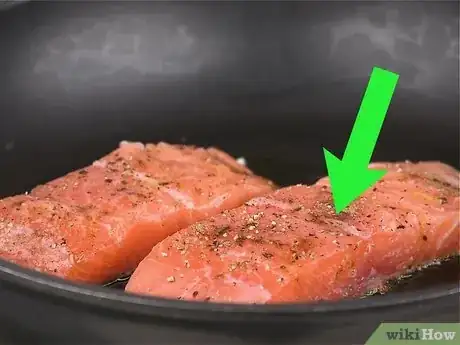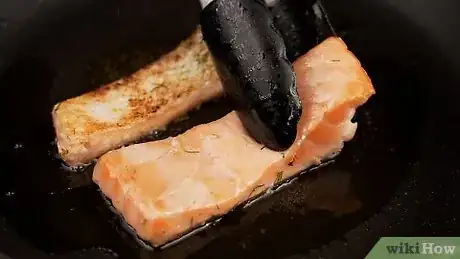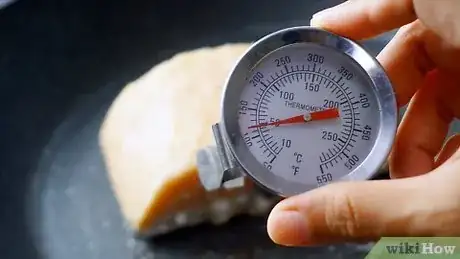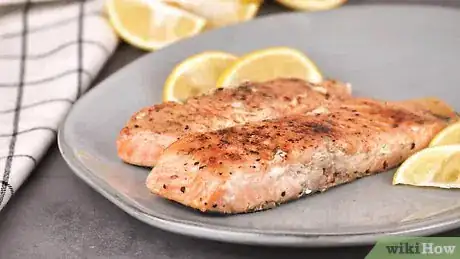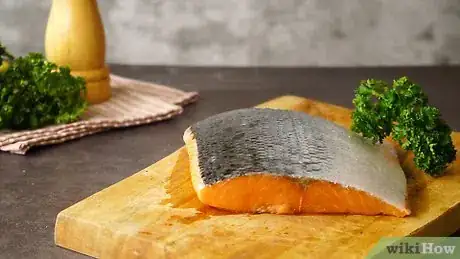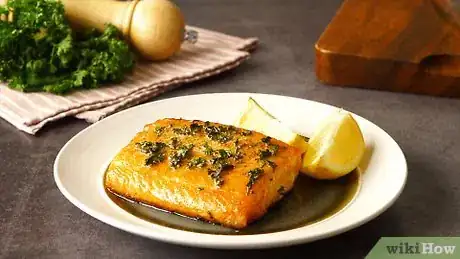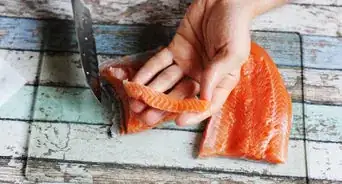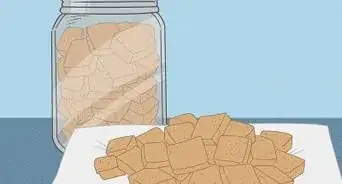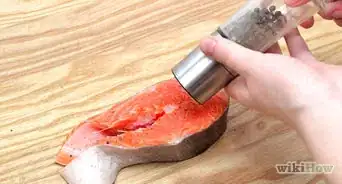This article was co-authored by Vanna Tran, a trusted member of wikiHow's volunteer community. Vanna Tran is a home cook who started cooking with her mother at a very young age. She has catered events and hosted pop-up dinners in the San Francisco Bay Area for over 5 years.
This article has been viewed 451,809 times.
Learn more...
Salmon is a delicious fish that can be pan-fried, grilled, or broiled for a healthy dinner. But preparing the fish at home can be tough because it can be very easy to overcook it. Checking the color and texture of the fish can help give you an idea whether it's done, but using a thermometer is the most foolproof way to tell if the salmon's cooked to your desired doneness. You can work to prevent overcooking by preparing the salmon in the right way for cooking, though, so you never wind up with dry salmon again.
Steps
Color and Texture
-
1Press the tip of a knife into the thickest part of the salmon. You’ll need to look at the interior of the fish to see if it’s finished cooking. To get a peek at the inside of the salmon, use just the tip of a sharp knife to push into it about halfway down.[1]
- You can use a fork, but they usually do more damage to the salmon, which may mar your presentation.
-
2Study the salmon’s color. While the fish should be an opaque white, beige, or brown on the outside depending on the cooking method, it should still be a slightly translucent pink in the center.[2] If the center of the salmon is opaque, it’s likely overcooked. If the center is completely translucent, it likely needs to cook further.[3]Advertisement
-
3Check to see how easily the fish gives way. You don’t want the salmon to flake. If it flakes, it’s likely overcooked and dried out. Instead, the salmon should resist flaking but give way and pull apart into pieces when you press the knife into it.[4]
-
4Take the salmon off the heat and let it finish cooking for several minutes. If the salmon is opaque on the outside and slightly translucent on the inside and gives slightly when you poke it, it’s likely done. It will still continue to cook for several minutes off the heat, so remove it from the stove, oven, or grill, and allow it to sit for about 5 minutes before serving.[5]
- Because the salmon continues to cook off the heat, it's okay if you remove when it's slightly under cooked. If you wait until the center is a slightly translucent pink and the fish gives way easily with the fork, it should be perfectly done after it sits.
Temperature
-
1Insert a thermometer into the thickest part of the salmon. An instant-read thermometer works best for checking the salmon’s temperature. Make sure to stick the test end in the thickest part of the fish, though, because that area will take the longest time to cook.[6]
- You can purchase an instant-read thermometer at most home goods and cooking supply stores.
-
2Verify the temperature is at least 110°F (43°C) but below 140°F (60°C). If the temperature is below 110°F (43°C), the salmon is essentially raw. At 110°F to 125°F (43°C to 52°C ), the fish is medium-rare. Between 125°F and 140°F, it’s medium to well-done. You don’t want it to reach above 140°F (60°C), though, because it will be dried out and tough.[7]
-
3Remove the salmon from heat and let it rest for several minutes. When you’ve reached your desired doneness, take the fish off the stove, grill, or out of the oven. Allow it to rest for 5 to 10 minutes to finish cooking, and serve.[8]
Proper Preparation
-
1Avoid removing the skin unless poaching. Taking the skin off the fish removes the barrier that protects it from the heat of the pan and reduces the risk of overcooking. If you’re poaching your salmon fillets, though, it’s okay to leave the skin on.[9]
-
2Season the salmon just before cooking. Adding salt and pepper is obviously key to flavorful fish, but if you add the salt too early before cooking, you’ll wind up drawing out all the moisture, which can lead to overcooking. Instead, add the salt and pepper to the salmon right before you cook it.[10]
-
3Cook the salmon skin side down. Even if you leave the skin on the salmon, you still run the risk of overcooking it if you don’t place it in the pan or on the grill or baking sheet the right way. Avoid placing the fish flesh side down or it will cook much too quickly.[11]
- To ensure even cooking, place a weighted object, like a dish or bowl, on top of the salmon as it cooks.[12]
-
4Finished.
Things You’ll Need
- Sharp knife
- Instant-read thermometer
References
- ↑ http://www.finecooking.com/article/how-to-tell-when-fish-is-truly-cooked
- ↑ Vanna Tran. Experienced Cook. Expert Interview. 15 March 2019.
- ↑ http://www.finecooking.com/article/how-to-tell-when-fish-is-truly-cooked
- ↑ https://www.bonappetit.com/test-kitchen/common-mistakes/article/common-mistakes-salmon
- ↑ http://www.beyondsalmon.com/2005/10/is-it-done.html
- ↑ Vanna Tran. Experienced Cook. Expert Interview. 15 March 2019.
- ↑ http://www.seriouseats.com/2012/06/how-to-cook-salmon-pan-fry-fish-food-lab.html
- ↑ http://www.seriouseats.com/2012/06/how-to-cook-salmon-pan-fry-fish-food-lab.html
- ↑ https://www.bonappetit.com/test-kitchen/common-mistakes/article/common-mistakes-salmon
- ↑ https://www.thekitchn.com/5-mistakes-to-avoid-when-cooking-salmon-230350
- ↑ https://www.bonappetit.com/test-kitchen/common-mistakes/article/common-mistakes-salmon
- ↑ Vanna Tran. Experienced Cook. Expert Interview. 15 March 2019.
About This Article
To tell if salmon is cooked, press a sharp knife into the center of the piece of fish. The salmon should be opaque white or beige on the outside and slightly translucent pink on the inside. It should also be easy to pull apart when you push the knife into it. However, if it’s flaky, it may be a bit overcooked. If you’re still not sure, insert a meat thermometer into the thickest part of the salmon. The temperature should be between 110° and 140° F (43-60° C). When you think the salmon is done, take it off the heat and let it rest for 5-10 minutes before serving it. It will continue to cook a little bit more as it rests. For more tips, including how to prepare the salmon before cooking, read on!
